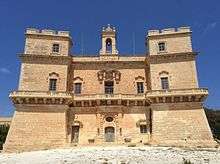Malta Environment and Planning Authority
The Malta Environment and Planning Authority (MEPA) was the national agency responsible for the environment and planning in Malta. The national agency was established to regulate the environment and planning on the Maltese islands of Malta, Gozo and other small islets of the Maltese archipelago. MEPA is bound to follow the regulations of the Environment Protection Act (2001) and the Development Planning Act (1992) of the Laws of Malta. The national agency is also responsible for the implementation of Directives, Decisions and Regulations under the EU Environmental Acquis as Malta is a member of the European Union, while considering other recommendations and opinion of the Union. The Authority employs over 420 government workers, from a wide range of educational backgrounds, all within their merit of profession.[1][2] The Officio delle Case was the planning authority during the Order of St. John.[3]
Role
MEPA acts as the national representation under a number of international environmental conventions and multilateral agreements. These include information supported by the Aarhus Convention:[1]
- On access to information;
- Public participation in decision-making;
- Access to justice in environmental matters.
Governance
The Agency is governed by a board of professional, whose responsibility is to provide strategic guidance within, laid by the laws of Malta. The board comprising a maximum of 15 personnel led by the Executive Chairman, Perit Vincent Cassar.[4] Members within the board, include two representative members of the Parliament of Malta, who are knowledgeable and experienced about matters relating to the environment and development such ranging from: commercial, industrial and social affairs. A number of appointed boards and committees provide strategic guidance or expert advise to the directorates to ensure that the organization fulfils its functions and responsibilities efficiently and effectively, in line with legal obligations.[1]
Responsibility
MEPA’s operational functions and responsibilities are carried out by the work of four main structures, namely:[1]
- The Chairman’s Office is responsible for providing the framework within which the MEPA Board together with the Commissions and Committees operate.
- The secretariat is the point of reference for issuing and communicating the Board's and Commissions' decisions and in this context are a primary point of contact for ministries, departments and agencies as well as the general public.
- The Communications Office and Complaints office are an integral part of the function of this office.
Aim
The Chief Executive Officer is responsible for the implementation of the aims and supervise and control the Directorates. The CEO and other directors, are responsible for developing the necessary strategies. The Planning Directorate processes environment and planning applications. It is responsible for enforcement, policy development and plan making, transport planning and research and other.[1][5]
Enforcement
The Enforcement Directorate is responsible for both Development Control and Environmental Protection and for supporting the Authority in enforcement campaigns including Direct Action, enforcement, surveillance and actions as necessary to ensure compliance with the building development permits and to protect the environment to help achieve a sustainable environmental improvement. The Environment Protection Directorate advises Government on environmental standards and policies, draws up plans and provides a licensing regime to safeguard and monitor the environment and controls the activities having environmental impact. The Directorate for Corporate Services, is responsible for Human Resources, Information Technology, Mapping and Land-surveying, support services and Finance. There are a number of boards and committees, which provide strategic guidance for the Directorates to ensure the organization fulfils its functions and responsibilities efficiently and effectively, in line with its legal obligations.[1]
Grading of property

Here is an incomplete list of graded property by MEPA according to category.[6] The below property are named according to the official name used by MEPA and not as how they are known among the public.[7]
Grade 1: Building at this grade have great historical and architectonical values and may not be altered[7]
- Palazzo Dorell[8]
- Palazzo Parisio (Valletta)[9]
- San Anton Palace[10]
- Villa Bologna[11]
- Villa Francia[12]
- Lija Belvedere Tower[9]
- La Borsa[13]
- Ponsonby's Column[14]
Grade 2: Building at this grade have historical and architectonical value and can have moderate alterations[7]
- Palazzo Dragonara[15]
- Palazzo Nasciaro
Grade 3: Building at this grade are not considered important and can be demolished[7]
References
- "Archived copy". Archived from the original on 2015-08-18. Retrieved 2015-08-25.CS1 maint: archived copy as title (link)
- "Archived copy". Archived from the original on 2009-10-02. Retrieved 2015-08-25.CS1 maint: archived copy as title (link)
- "Underneath Valletta". www.schoolnet.gov.mt. Retrieved 23 January 2018.
- "Malta Environment and Planning Authority". www.gov.mt. Retrieved 2017-12-08.
- "MEPA executive chairman at government's mercy". Retrieved 23 January 2018.
- https://issuu.com/planningauthority/docs/pa_captions_booklet
- "Archived copy". Archived from the original on 2016-03-04. Retrieved 2015-09-04.CS1 maint: archived copy as title (link)
- "Palazzo Dorell" (PDF). National Inventory of the Cultural Property of the Maltese Islands. 28 December 2012. Retrieved 5 June 2015.
- "Archived copy". Archived from the original on 2016-03-04. Retrieved 2015-09-04.CS1 maint: archived copy as title (link)
- Ltd, Allied Newspapers. "San Anton Palace and garden, Attard". Retrieved 23 January 2018.
- Ltd, Allied Newspapers. "Villa Bologna given Grade 1 protection". Retrieved 23 January 2018.
- http://www.culturalheritage.gov.mt/filebank/inventory/01176.pdf
- "Archived copy". Archived from the original on 2016-03-04. Retrieved 2015-09-04.CS1 maint: archived copy as title (link)
- "One World - Protecting the most significant buildings, monuments and features of Valletta (32) - Ponsomby's Column". Times of Malta. 2 August 2008. Retrieved 4 September 2015.
- "Archived copy". Archived from the original on 2016-03-04. Retrieved 2015-10-02.CS1 maint: archived copy as title (link)